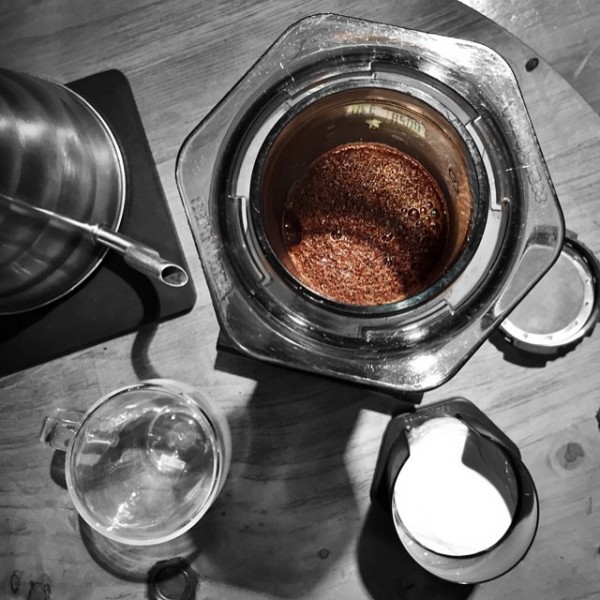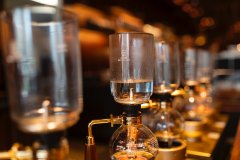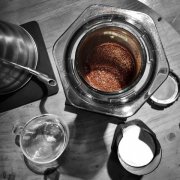Siphon pot coffee brewing step explanation _ siphon pot coffee making process teaching video

Professional coffee knowledge exchange more coffee bean information please follow the coffee workshop (Wechat official account cafe_style)
The siphon pot (Siphon), which originated in England, is a tool that uses the pressure caused by boiling water to make coffee. The siphon pot is constructed as an upper and lower pot connected by a pipe in the middle, and the lower pot filled with hot water will first be heated by an alcohol lamp or a gas lamp. Because at 1 atmospheric pressure, the volume ratio of 1 gram of liquid water to 1 gram of water vapor is 1100, when the volume of steam in the kettle increases with the temperature, the liquid water can be easily pushed through the conduit to the upper pot filled with filter cloth and coffee powder, and the water will continue to be supported by an endless stream of steam on the pot.
When the heating stops, the air in the lower pot gradually cools and shrinks, while the coffee liquid that has been soaked in hot water in the upper pot will flow back to the lower pot because it has lost the support of steam, and the coffee grounds will be blocked by a filter cloth and left in the upper pot. Finally, remove the upper pot and you can enjoy the coffee in the lower pot.
Characteristics of siphon coffee
Full-bodied taste: combined with the full-bodied espresso and hierarchical hand-brewed coffee, it is suitable for brewing individual coffee.
Difficult to operate: because the coffee powder will be scorched when the water temperature is too high, the coffee powder will taste bitter, soaking for a long time will produce astringent taste, and excessive stirring will produce sour taste, so the siphon pot needs considerable experience to be able to use the appropriate tool.
Full demonstration of siphon coffee-extraction of coffee for 2 people
Step 1:
Pour 2 servings of coffee powder (25g) into the upper pot. When pouring into the upper pot, the coffee powder is easily attached to the inner wall of the upper pot, so you must be very careful. Mr. Kira, the siphon barista, pours the coffee powder into the pot in a stainless steel cup with a diameter of 6 centimeters. Because it is made of stainless steel, the coffee powder will not be electrostatically attached to the pot wall.
Pour the hot water into the pot of 160ml, ready to begin to extract coffee. The hot water in the next pot is boiled and inserted into the upper pot. After the hot water rises, the firepower is reduced a bit and stirred for the first time.
The first stirring: take the stirring rod as the axis, like holding a pen, holding the stirring stick with the thumb, index finger and middle finger, stirring against the clock, using the flat part of the end of the stirring bar to mix the coffee powder floating on the water into the water.
When stirring, you should avoid forming a whirlpool, with the mood of completely dissolving the coffee powder into the water, fix the wrist, take the hand-held part as the fulcrum, draw the ellipse with the mixing stick, and complete the mixing operation quickly.
If you stir too much, it is easy to form a double-layer structure of coffee powder and coffee liquid due to the excessive release of gas, and the whitening foam, coffee powder and coffee liquid form a three-layer structure from top to bottom, which means that the first stirring operation was very successful.
Step 2:
Replenish hot water immediately after the first stirring, replenish approximately boiling 95 degrees hot water, it is recommended to use a kettle that is easy to control the hot water temperature, through the thin spout to avoid damaging foam, coffee powder and liquid layer, gently inject hot water (replenish hot water: at least one whole pot (320ml), but enough to extract 2 people (300ml) coffee liquid), so that the whole layered structure can rise, impregnation time is 15 seconds. The replenishment of hot water must be completed within time.
Step 3:
Set the soaking time (the extraction time of siphon coffee is basically set within 60 seconds, turn off the heat at the end of the time, stir again after removing the heat source, the mixing direction is the same, the extraction is handled properly, and the coffee powder accumulates into a hill.
Complete the extraction of coffee solution for 2 people.
Siphon pot skills: pressing method, stirring method, pendulum method, cross method
After mastering the basic operation method of siphon pot, in order to further improve the level of siphon use, it is undoubtedly a very important topic to study how to stir. Different stirring will lead to subtle changes in the flavor of coffee. We can try how different stirring will change the coffee from the two aspects of stirring technique and timing.
The grip of the stirring rod
Take the stirring rod as the axis, as if holding a pen, holding the stirring rod with thumb, index finger and 2 fingers.
The middle finger against the stirring rod.
The method of stirring
Although there is a non-mainstream strong mixing method, but the vast majority of stirring have reached a consensus, that is, stirring should be gentle, no matter what means, do not force too hard. But remember that gentle does not mean slow, not like slow motion even if gentle, gentle should be a kind of feeling, is the grasp of strength. Here are some common techniques.
1. Down pressing method
In fact, the pressing method is not stirring, but pressing down the coffee powder originally floating on the water, so that the powder can be in close contact with the water. When pressing down, let one end of the stirring stick slide along the wall of the upper pot, and slowly press the powder into the surface of the water, not to the end, just shallow. The core of the pressing method is quietness, and there must be a state of mind that does not disturb coffee extraction in order to give full play to this technique. This technique is generally used when the water is stirred for the first time as soon as the water rises to the top of the pot.
two。 Stirring method
The circle method is very easy to master and is usually more like stirring. When stirring, you should also stir gently, insert the mixing piece into the liquid surface at 1/3 of the depth of the kettle, and then stir it in a circle along the kettle wall. This technique is the easiest way to make what the Taiwanese call a hill-shaped powder.
3. Pendulum method
The pendulum method allows your mixing stick to be carried out in the arc of the pendulum, and when stirring should also be gentle, insert the mixing piece into the liquid surface to 1/3 of the depth of the upper pot, then press the coffee powder along the arc shown in figures 1 to 2 below, and pull the mixing stick to the pot wall (try not to touch the pot wall). This technique is the easiest way to make the coffee taste softer.
4. Cross method
The cross method should still be gentle, and the handle will be more demanding, and the stirring trajectory is shown in the picture. Stir the pieces gently back and forth with "cross" on the surface of the water. This technique can be used alone or with the pendulum method.
Now let's take [Yejiaxuefei Red Cherry] as an example to make a pot of coffee with these two methods of pollination.
[working principle]
The main principle of coffee extraction in the siphon pot is realized through the pressure difference. First, the lower cup of water is heated to boiling, and then inserted into the upper pot, so that the lower pot is in a state of high pressure. Due to the pressure difference between the lower pot and the upper pot, the hot water is mixed with the upper pot coffee powder and extracted. After the extraction process, the fire source of the lower pot is removed, so that the pressure difference between the lower pot and the upper pot is instantly reduced. The siphon effect between the upper pot and the lower pot will cause the coffee extract to return to the lower cup. If you want to speed up the reflux rate of the coffee extract, you can wipe the lower pot with a dishcloth, which can make the pressure difference between the upper pot and the lower pot smaller and the coffee extract reflux faster.
[preparatory work]
1. Add water to the siphon pot, for example, to make coffee for two, then add water to the 5mm above the siphon pot sign for two, because the powder absorbs water, so if you want to make coffee for two, you have to add more water appropriately.
two。 Grind coffee beans, prepare 25 grams of coffee powder (about 15g in a single cup) and moderate grinding (4 scales of small Fuji ghost teeth), that is, the particles are between white sugar and brown sugar.
3. After adding water, remember to dry the outside of the pot with a soft cloth, do not leave water stains, so as to avoid bursting the pot when heating.
4. Fill the next pot with hot water and heat it with a gas stove. Generally, a single cup of coffee uses about 180g of water and 300g for two (powder: 1:12).
5. When the water is heated enough to brew, put the filter in the upper pot and be sure to hook the hook as shown in the picture below. Otherwise, when the water from the pot rushes to the upper pot, the filter will be washed away.
Reference technique
Siphon pot technique | pressing method, stirring method, pendulum method, cross method
Case study
Degree of grinding: BG mill 5D
Hand grinding requires medium fineness, while siphon grinding is slightly thicker than hand grinding.
Powder / water ratio: 1:12
The extraction process of hand flushing is a process of cooling extraction. the extraction temperature of the latter stage is lower than that of the former stage, and it is not easy to overextract. Increasing the ratio of powder to water can improve the sense of hierarchy and richness. The ratio of hand flushing powder to water is usually between 1:14 and 1:16.
Siphon extraction is an immersion extraction process, the lower the extraction efficiency (concentration problem), but can maintain a high water temperature, so that a certain section of the flavor is relatively complete and prominent. The powder water is relatively small in order to highlight the sweet and sour flavor in the front and middle section, and avoid the woody flavor in the back section of the early extraction. The ratio of powder to water: 1:12-1:13
Water temperature and extraction
Yega Xuefei washed Kochel.
light baking
Siphon brewing parameters:
Powder weight: 20g;
Water temperature: 91 degrees;
Abrasion: BG mill: 5D;
Powder water ratio: 1:12;
Total brewing time: add powder after cooking, start timing after adding powder, turn off heat in 60 seconds
Specific siphon brewing techniques:
The method of adding powder after boiling water is adopted, namely, boiling water rises to the upper pot first, and then adding powder and stirring.
Step 1: Cook until fish-eye bubbles are produced, insert tightly into the pot; when the hot water rises, measure the water temperature, 91 degrees. Adjust the fire until the water column is stable and there are no bubbles in the pot. Add powder. Then cross over and gently press the powder to moisten completely.
Step 2: Steaming for 38 seconds, observing the bubble state of the powder layer, stirring for the first time, stirring for three rounds.
Step 3: Cook for 60 seconds, turn off the flame, wait for siphoning, and the coffee flows back to the next pot.
Siphon Flavor: Fruity with a lot of richness, honey sweet, cocoa notes with a little spice, body thick and lingering finish.
Costa Rica Canette Estate
Medium Roast (also suitable for medium roasted varieties such as Guatemala, Panama, Yunnan, Bolivia, etc.)
Siphon brewing parameters:
Powder weight: 20g;
Water temperature: 90 degrees;
Abrasion: BG mill: 5D;
Powder water ratio: 1:12;
Total brewing time: add flour after cooking, start timing after adding flour, turn off heat in 50 seconds
Specific siphon brewing techniques:
The method of adding powder after boiling water is adopted, namely, boiling water rises to the upper pot first, and then adding powder and stirring.
Step 1: Cook until fish-eye bubbles are produced, insert tightly into the pot; when the hot water rises, measure the water temperature, 90 degrees. Adjust the fire until the water column is stable and there are no bubbles in the pot. Add powder. Then cross over and gently press the powder to moisten completely.
Step 2: Steaming for 30 seconds, observing the bubble state of the powder layer, stirring for the first time, stirring for three rounds.
Step 3: Cook for 60 seconds, turn off the flame, wait for siphoning, and the coffee flows back to the next pot.
Siphon Flavor: The taste of raisin, honey and toffee is unforgettable, and the silky creamy texture is smooth and mellow (such as the long finish of Darjeeling black tea).
Gold mantinin
Medium to deep roast (also suitable for Blue Mountain, Colombia, Brazil, etc.)
Siphon brewing parameters:
Powder weight: 20g;
Water temperature: 90 degrees;
Degree of grinding: BG mill: 5D
Powder / water ratio: 1:13
Total cooking time: add powder, start the time, turn off the heat for 60 seconds
Specific siphon cooking techniques:
Use the post-powder method, that is, first boil the water to the pot, and then add powder to stir.
The first step: boil until the fisheye bubble is formed, insert the pot tightly; when the hot water rises to the pot, measure the water temperature, 90 degrees. Adjust the firepower until the water column is stable and there are no bubbles in the upper pot. Then the mixing method is completely wet.
The second step: steam for 10 seconds, observe the bubble state of the powder layer, stir in a circle for the first time, and stir three times.
Step 3: boil to 60 seconds, turn off the engine, wait for the siphon, and the coffee flows back to the next pot.
Siphon flavor: round, rich, herbs and bitterness, accompanied by caramel sweetness
Summary:
The hand flushing filtration method has a relatively large flavor, and the difference of manipulation, temperature and water flow rate will affect the flavor change.
On the contrary, siphon is less flexible, and the space for adjusting the flavor of coffee beans is not as rich as that made by hand. As long as the production does not fail, it is almost easy to standardize. The water temperature is about 90 degrees, and the grinding is coarser. According to the baking degree (from shallow to deep), the cooking time is shortened. If the time remains the same, the deeply roasted beans will be very bitter and easy to be extracted. However, this is also adjusted according to personal taste, and many coffee makers in Japan like to brew for more than 4 minutes.
Siphon brewed coffee is a favorite of many coffee fans. Some people say that because it can extract the most perfect part of coffee, especially if the characteristics of coffee beans have that kind of refreshing and clear acid, and the acid has a mellow flavor, siphon cooking can give full play to the characteristics of this kind of coffee.
END
Important Notice :
前街咖啡 FrontStreet Coffee has moved to new addredd:
FrontStreet Coffee Address: 315,Donghua East Road,GuangZhou
Tel:020 38364473
- Prev

Analysis of the principle of Starbucks siphon pot what are the tricks and skills of making coffee in Starbucks siphon pot
Professional coffee knowledge exchange more coffee bean information please pay attention to the coffee workshop (Wechat official account cafe_style) siphon coffee using immersion extraction. As the name implies, the principle is to soak the coffee powder in a container and interact with hot water for a period of time. Dissolution and diffusion to release the flavor and aroma of coffee smoothly, and to complete the extraction before the miscellaneous flavor is precipitated.
- Next

Siphon pot coffee brewing step explanation _ siphon pot coffee making process teaching video
Professional coffee knowledge exchange more coffee bean information Please pay attention to the coffee workshop (Wechat official account cafe_style) siphon pot (Siphon), which originated in the United Kingdom, is a tool that uses the pressure caused by boiling water to make coffee. The siphon pot is constructed as an upper and lower pot connected by a conduit in the middle, and the lower pot filled with hot water is first heated by an alcohol lamp or a gas l because at 1 atmospheric pressure
Related
- Beginners will see the "Coffee pull flower" guide!
- What is the difference between ice blog purified milk and ordinary milk coffee?
- Why is the Philippines the largest producer of crops in Liberia?
- For coffee extraction, should the fine powder be retained?
- How does extracted espresso fill pressed powder? How much strength does it take to press the powder?
- How to make jasmine cold extract coffee? Is the jasmine + latte good?
- Will this little toy really make the coffee taste better? How does Lily Drip affect coffee extraction?
- Will the action of slapping the filter cup also affect coffee extraction?
- What's the difference between powder-to-water ratio and powder-to-liquid ratio?
- What is the Ethiopian local species? What does it have to do with Heirloom native species?

